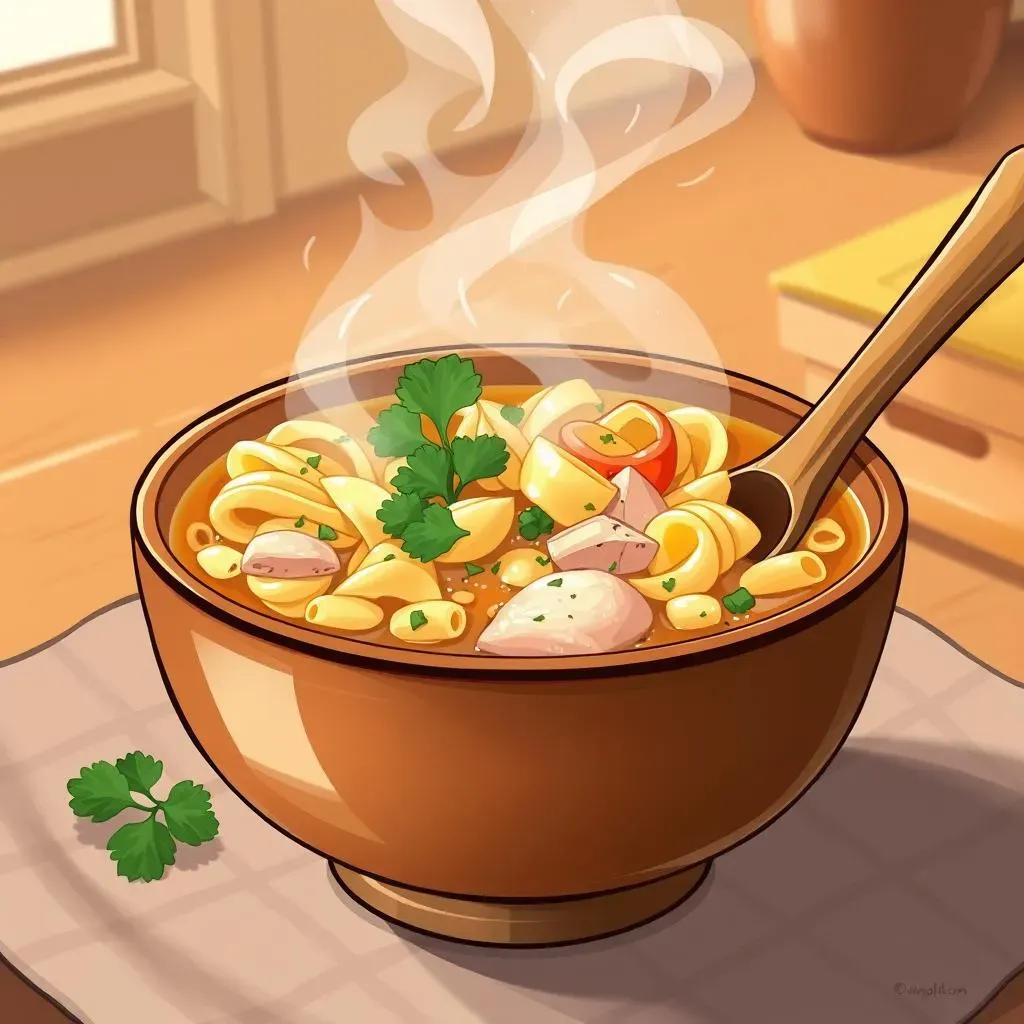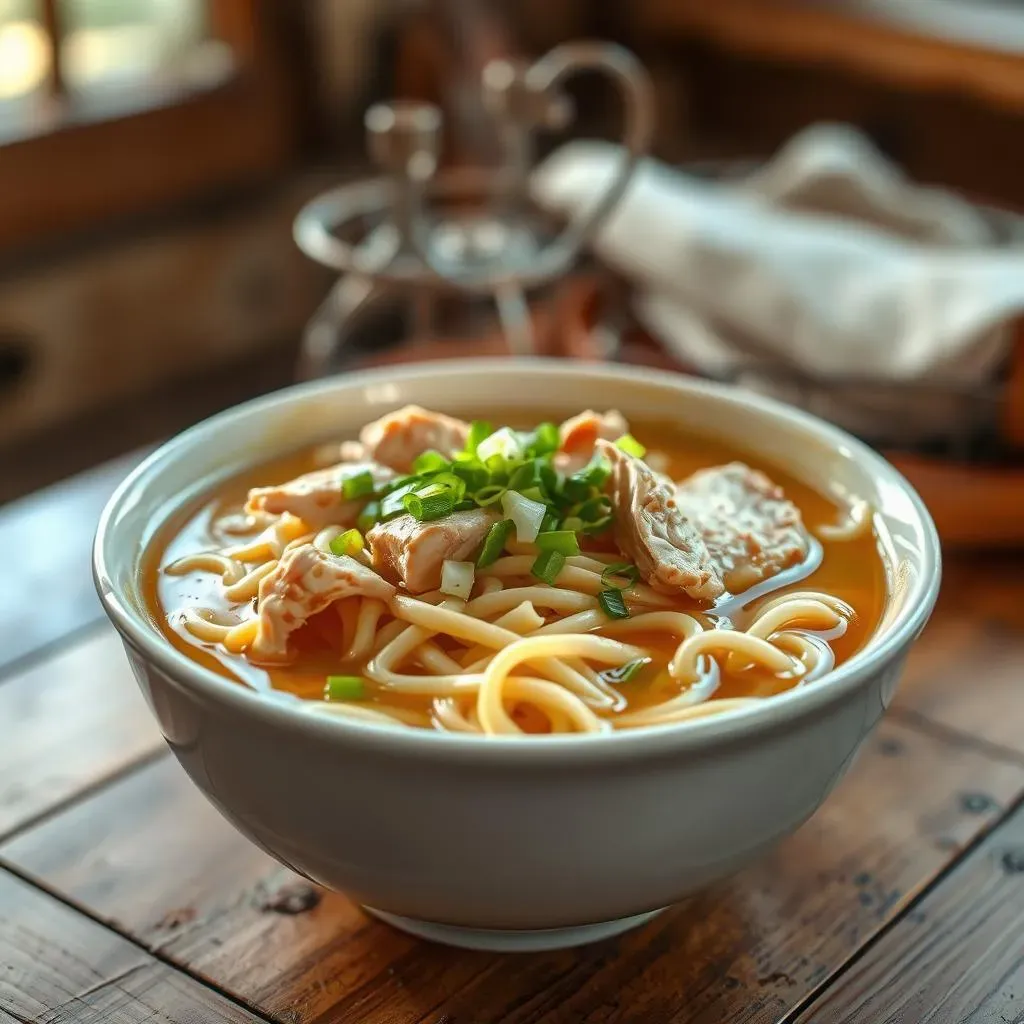Table of Contents
Ever stared into a pot of chicken soup, wondering if you picked the right noodles? I've been there, elbow-deep in broth, pondering the very same question: which noodles for chicken soup work best? It's a crucial decision, honestly. The wrong choice can lead to a mushy mess, while the perfect noodle will bring a bowl of comforting goodness to the next level. This isn't just about filling your bowl; it's about crafting a symphony of flavors and textures that makes each spoonful a delight. Think of it like this: the noodles are the supporting cast to your chicken soup's leading role, and we all know a good supporting cast can make or break the show. So, let's unpack this noodle mystery together. We'll explore the classic egg noodle, venture into other pasta possibilities, and I'll share my best tips to avoid common noodle mishaps. Get ready to elevate your chicken soup game!
The Great Noodle Debate: Which Noodles Work Best in Chicken Soup?

The Great Noodle Debate: Which Noodles Work Best in Chicken Soup?
let's get real. When it comes to chicken soup, the noodles are not just an afterthought; they're a major player. It's like casting the right actor for a role—you wouldn't put a comedian in a serious drama, right? Same goes for noodles. You've got your classic egg noodles, those soft, comforting ribbons that feel like a warm hug. Then, you have a whole world of pasta shapes, from the sturdy rotini to the delicate orzo, each bringing something different to the pot. The big question is, how do you decide? It's not just about what you like; it's about what works. Some noodles get soggy fast, some hold their shape like a champ, and some soak up all that delicious broth. So, choosing which noodle to use is a careful balance of personal preference and noodle performance.
Noodle Type | Texture | Broth Absorption | Best Use Case |
|---|---|---|---|
Egg Noodles | Soft, pillowy | High | Classic, comforting soup |
Rotini | Firm, chewy | Medium | Hearty soups with lots of veggies |
Orzo | Small, delicate | Medium | Light, brothy soups |
Egg Noodles vs. Other Pasta: A Chicken Soup Showdown

Egg Noodles vs. Other Pasta: A Chicken Soup Showdown
The Case for Egg Noodles: A Classic Choice
Let's talk about egg noodles, the old faithful of chicken soup. These guys are like the cozy blanket of the noodle world—soft, comforting, and they just feel right. Their slightly chewy texture and mild flavor make them perfect for soaking up all that rich chicken broth. It’s almost like they were born for this job. I remember my grandma always making her chicken soup with egg noodles. The way they would plump up in the broth, each bite was like a little cloud of deliciousness. There's a reason they're a classic, they get the job done and they do it well.
Venturing Beyond: Other Pasta Possibilities
But wait, there’s more to noodles than just the classic egg noodle! Don't get me wrong, I love egg noodles but sometimes you want to mix it up. This is where other pasta shapes come into play. Rotini, with its twists and turns, holds onto the broth and any little bits of chicken and veggies. Orzo, those tiny rice-shaped pasta, creates a lighter, more delicate soup. And then there’s ditalini, those small tubes that are perfect for little spoons and little mouths. Each shape brings something different to the table. It's like choosing a new outfit, sometimes you want to go classic, sometimes you want to try something bold.
Pasta Type | Shape | Texture in Soup | Flavor Profile |
|---|---|---|---|
Rotini | Spirals | Firm, Holds Shape | Neutral |
Orzo | Rice-shaped | Delicate, Light | Mild |
Ditalini | Small Tubes | Tender, Soft | Slightly Nutty |
The Verdict: It's All About Personal Taste
Ultimately, the 'best' noodle for chicken soup is whatever you prefer. There's no right or wrong answer here. Maybe you're a die-hard egg noodle fan, and that's totally fine! Or perhaps you like the heartiness of rotini or the lightness of orzo. The beauty of cooking is that you get to experiment. Try different shapes, see what you like, and don't be afraid to break from the norm. It’s your soup, your rules, so make it how you want it. And who knows, you might discover a new favorite!
Cooking Tips and Tricks: Getting Your Chicken Soup Noodles Just Right

Cooking Tips and Tricks: Getting Your Chicken Soup Noodles Just Right
Timing is Everything: When to Add Your Noodles
so you've picked your noodles, now it's time to get cooking. But here's a pro-tip: don't throw those noodles in too early. Adding them too soon will result in a pot of mushy noodles that have absorbed all the broth and lost their shape. The best time to add your noodles is towards the end of the cooking process, usually about 10-15 minutes before the soup is done. This gives them enough time to cook through without getting overcooked. Think of it like adding the final touches to a painting, you wouldn't add the details before the background is done, right?
I've made this mistake more times than I care to admit! There was this one time I added the noodles at the same time as all the veggies and chicken, thinking it would be more efficient. Let me tell you, it was not efficient. The noodles turned into a big, gloopy mess, and the soup was more like a noodle stew. Lesson learned: patience is key when it comes to noodle timing.
Preventing the Dreaded Mush: Noodle Cooking Strategies
Alright, let's talk about how to keep your noodles from turning into a soggy disaster. First things first, don't overcook them! Overcooked noodles are the enemy of a good chicken soup. Always follow the package instructions, but start checking them a minute or two before the recommended time. You want them to be al dente—firm to the bite, not mushy. Also, consider cooking your noodles separately. If you’re making a big batch of soup that will last for a few days, cook the noodles separately and add them to individual bowls as you serve. This way, they won’t continue to absorb broth and get soggy while the soup sits.
Another trick? If you’re using egg noodles and making a large batch of soup, you can lightly coat them in a bit of olive oil before adding them to the soup. This will help prevent them from sticking together and becoming a big clump. It's like giving them a little armor to protect against the broth. And remember, always taste as you go. Adjust the cooking time as needed, and you'll be on your way to noodle perfection.
Problem | Solution |
|---|---|
Mushy Noodles | Add noodles towards the end of cooking. Check for doneness a few minutes before the suggested time. |
Overcooked Noodles | Cook noodles al dente. Consider cooking them separately and adding them when serving. |
Sticking Noodles | Lightly coat noodles in olive oil before adding to soup. |
The Final Scoop: Noodle Know-How for Soup Success
So, there you have it. Navigating the world of which noodles for chicken soup doesn't have to be a daunting task. Whether you're a die-hard egg noodle fan or someone who likes to experiment with different shapes, the key is to choose what you enjoy and cook them properly. Remember, the perfect noodle enhances your soup, it doesn't overpower it. So, go forth, armed with this knowledge, and create some truly spectacular chicken noodle soup. Don't be afraid to try new things, and most importantly, enjoy the process. Now, if you'll excuse me, I think I hear a pot of soup calling my name.
